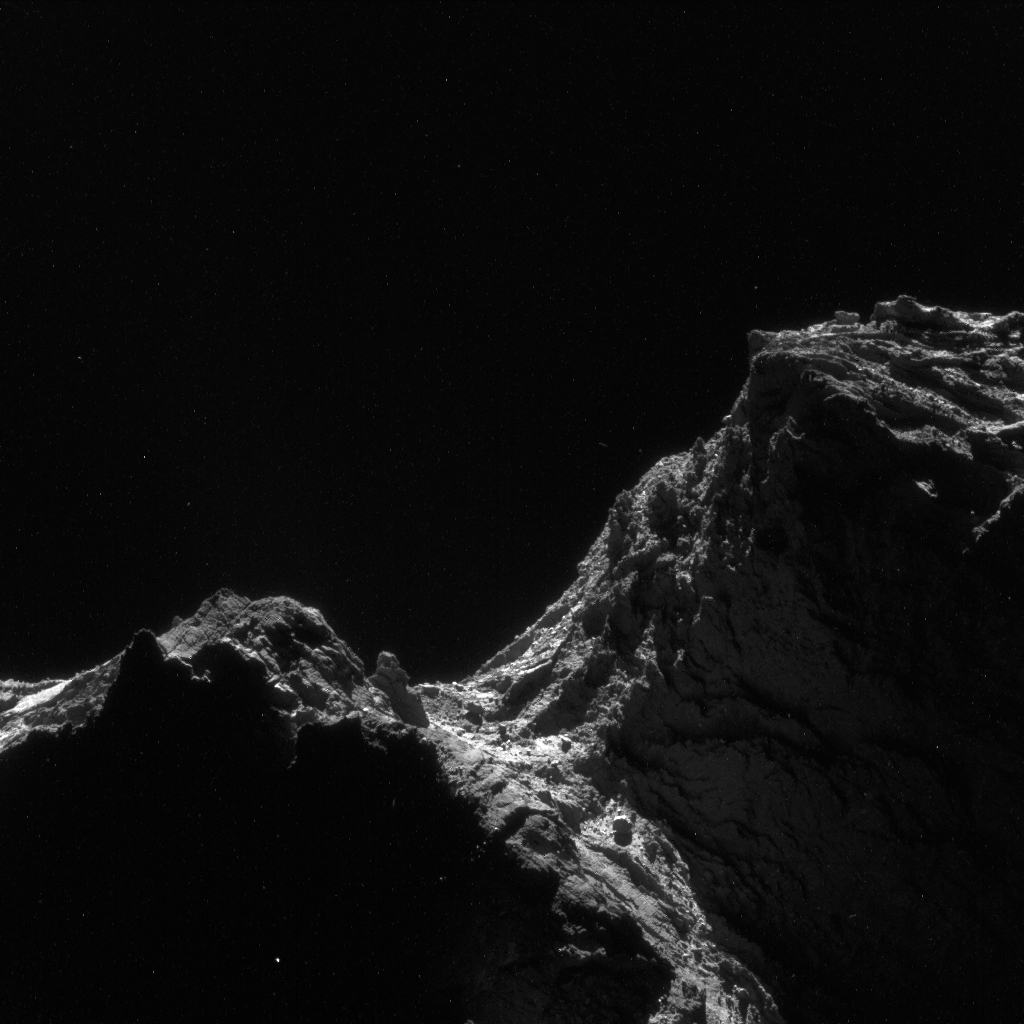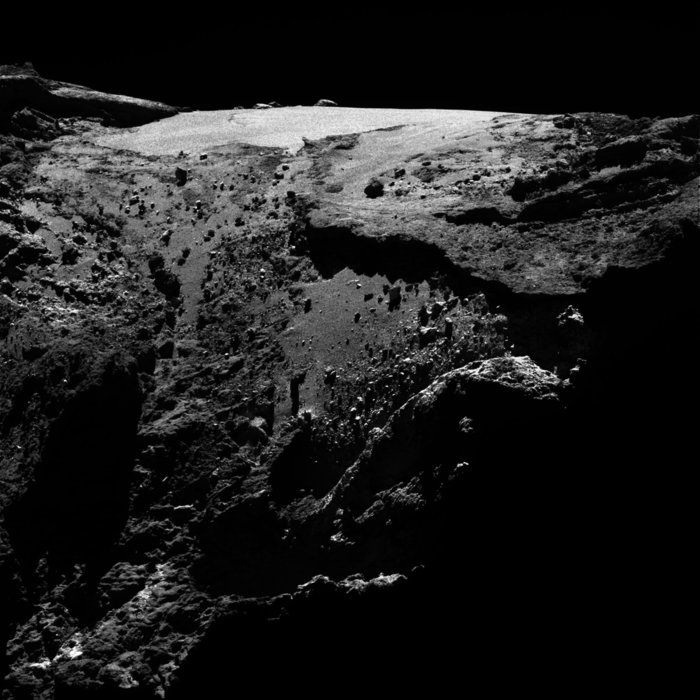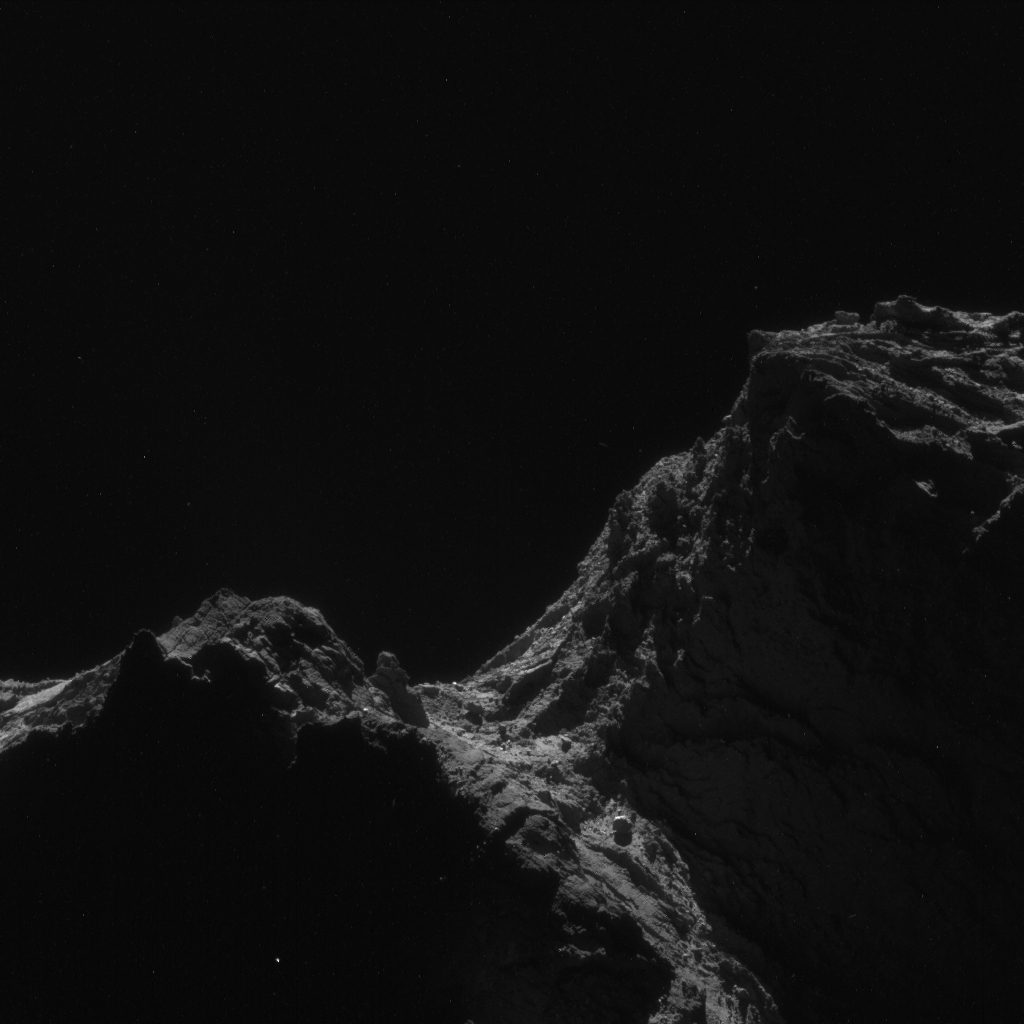This week’s CometWatch was taken by Rosetta’s NAVCAM on 24 April 2016, 28 km from the nucleus of Comet 67P/Churyumov-Gerasimenko.

Enhanced NAVCAM image of Comet 67P/C-G taken on 24 April 2016, 28 km from the nucleus. The scale is 2.4 m/pixel and the image measures 2.4 km across. Credits: ESA/Rosetta/NAVCAM – CC BY-SA IGO 3.0.
It captures a beautiful ‘skyline’ taking in parts of the comet’s southern hemisphere regions.
Bes and Geb on the comet’s large lobe lie to the far left of the scene. Zooming in to the exposed cliff faces reveals criss-cross fracture patterns that have also been identified in many other locations on the comet (see an earlier blog post ‘Do comet fractures drive surface evolution?’ for more).
The boulder-strewn neck region in the middle of the view features Sobek, which transitions up through Neith and Wosret on the small comet lobe to the right.

OSIRIS narrow-angle camera image taken on 23 April 2016, when Rosetta was 29.6 km from Comet 67P/Churyumov–Gerasimenko. The scale is 0.53 m/pixel. Credit: ESA/Rosetta/MPS for OSIRIS Team MPS/UPD/LAM/IAA/SSO/INTA/UPM/DASP/IDA.
Also released this week by Rosetta’s OSIRIS team was a stunning narrow-angle camera shot capturing an oblique view over Imhotep (above). In this orientation, Bes lies to the left and Khonsu is to the right. The view complements an earlier release from the OSIRIS wide-angle camera taken from about 12 km.
The original NAVCAM image from today’s release is provided below:










Discussion: 4 comments
Foamy geysers, even if unable to reach surface, could level gravel surfaces. They could progressively ‘sink’ those former surfaces also, by sintering/unsintering cycles.
Suspecting this later phenomena more common than avalanche related depressions.
Emily, some of my sadness, is about knowing You and all of your Team has & have had lots of exciting ideas all this Time, but -as Insiders- unable to comment Them in the open Internet.
Imhotep could be the ‘Yellowstone’ of foam-ruptions. And loosing gravitational high by progressive material-structure collapsing [Foam-ruptions don’t have to go all the way up to surface].
Remember those circular features? Here’s yet another more proposed mechanism. Commenting also that Robin was first chatting of cry-volcanism concepts here at Rosetta’s Blog.
‘dandelion’ particulate speculatively also related to ‘foaming’ processes.
https://blogs.esa.int/rosetta/2015/04/09/giada-investigates-comets-fluffy-dust-grains/
Also to Gerald’s ‘translucent’, ‘atmospheric’ particulate properties.
Gerald
You linked a photo a few weeks ago in which you identified nested V-shapes in the neck at Anuket. It was a view from above. I was going to say at the time that it was an optical illusion and that the upper arms of the V were in fact the head lobe rim and strata above it. I didn’t get round to saying it though. You had a theory as to what the V’s might be so it’s important to let you know this because you may wish to modify it.
This post’s photo is of the same area but it’s from a vantage point that’s lower down, looking more upwards towards the underside of the head rim. You can see the same formation of apparently nested V’s as in the other photo but you can now see that the upper arms of the V’s are in fact the head rim and strata above it.
I can’t find the photo you linked but I think the lower arms were the lines going straight down the neck in this picture (in sunlight but with their ribs in high relief). If so, it means that your V shapes that looked as if they were 45° to each other, are actually nearer 90° to each other, with one set of arms down the neck and the other set of arms across the head beyond the head rim. However I do see some sloping lines in the shadows but I don’t think it was these that formed the lower arms.
What’s for sure is that the upper V arms are the head lobe strata not on the Anuket neck and are running at roughly 90° to the ‘vertical’ neck when the duck is in upright mode.